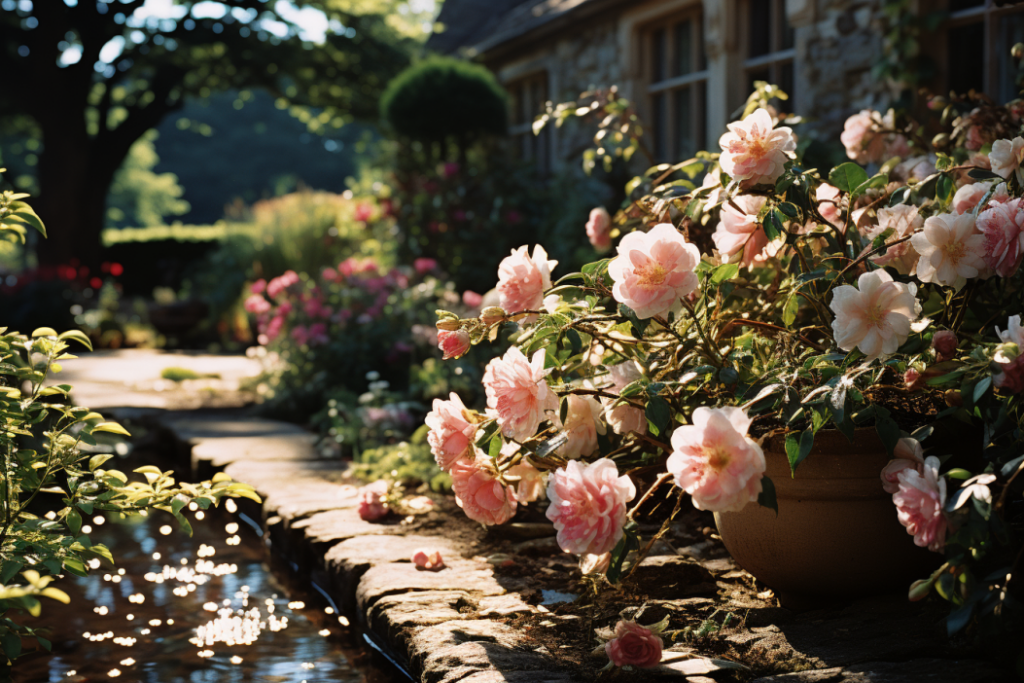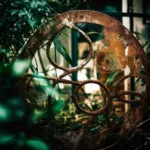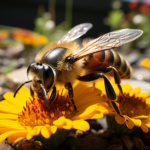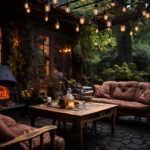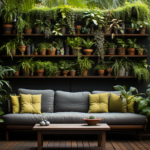Table of Contents
Enhance Your Garden’s Aesthetics with These Effective English Garden Design Tips
Every gardener wants a little piece of England in their backyard! The English garden is a timeless treasure that symbolizes classic elegance, lush blossoms, and pristine lawns. If you’re looking to create a picturesque paradise in your little patch of green, you’re in the right place. In this article, we’ll give you five easy tips to help you design the perfect English garden. Whether you’re a seasoned gardener or a newbie, these tips are straightforward, practical, and will help transform your garden into a scenic haven! So, grab your trowel, put on your gardening gloves, and let’s get started on making your dream English garden a reality!
Choose the right plants
When creating your English garden, it’s vital to choose the right plants to match your garden’s design and layout. It would be best to consider plants that typically thrive in England’s climate, such as lavender, roses, daisies, and hollyhocks. You can also add hydrangeas, delphiniums, foxgloves, and peonies to your garden. These plants provide varying colors, heights, and textures, creating a vibrant and aesthetically pleasing atmosphere.
When choosing the plants, consider their blooming season and their sunlight and water requirements. Ensure that you give each plant enough space to grow and reach their full potential. A crowded garden is not only unpleasant to look at but can also lead to disease and reduced growth of the plants. Therefore, plan your garden accordingly, and arrange the plants in a way that complements one another and promotes growth.
Remember to maintain and trim your plants regularly to keep them looking healthy and refreshing. Deadhead the plants, prune and cut back the bushes, and remove any weeds that may hinder their growth.
In conclusion, selecting the right plants is essential when designing an English garden. It creates a cohesive and vibrant atmosphere that everyone will appreciate. Therefore, consider the season, climate, and each plant’s requirement to improve the aesthetics of your garden. Pay attention to details, and your garden will undoubtedly look and feel like a perfect piece of England in your backyard.
Create focal points
English gardens are all about creating focal points that catch the eye and add character and charm to the space. With the right focal points, you can transform a drab garden into a vibrant and visually appealing landscape!
Here are some easy ways to create focal points in your English garden:
- Arbors and Trellises: A simple archway or trellis can add height and interest to any garden. These structures can be decorated with climbing plants like roses, ivy, and wisteria to create a stunning focal point.
- Water Features: The sound of trickling water can be incredibly relaxing, and water features like fountains, ponds, and waterfalls make excellent focal points in any garden.
- Sculptures and Ornaments: Statues, birdbaths, sundials, and other ornaments add personality and character to a garden. Be sure to choose pieces that complement your garden’s design and aesthetic.
- Seating areas: A cozy seating area is not only functional but can also serve as an attractive focal point in your garden. Add some comfortable chairs, a table, and a few potted plants to create a peaceful retreat.
Keep in mind that too many focal points can make your garden look cluttered, so try to limit them to a few key items. Also, be sure to place them in areas that are easily visible and add to the overall beauty of your garden.
Choose the Right Plants
One of the primary features of an English garden is its colorful and diverse plant life. From fragrant roses to vibrant daisies and charming lavender, the options are endless. However, not all plants are suitable for an English garden, so it’s important to choose wisely.
Here are some easy tips when selecting plants for your English garden:
- Choose perennials: Unlike annuals, perennials come back each year and are easier to maintain.
- Go for color: English gardens are all about color, so choose plants that are vibrant and eye-catching. Some good options include roses, delphiniums, irises, and peonies.
- Mix things up: Don’t be afraid to mix different types of plants, textures, and heights. Variety adds interest and makes your garden feel natural and effortless.
- Choose the right location: When selecting plants, consider the sunlight and moisture requirements of each species and place them in areas of your garden where they can thrive.
With these basic tips, you’ll be well on your way to creating a beautiful English garden filled with a rich variety of plants and charming focal points!
Incorporate hardscaping
Incorporating hardscaping is essential to any successful English garden design, and it’s easy to see why. Hardscaping elements provide structure, texture and creates the illusion of outdoor living space. However, it’s vital to integrate hardscaping elements that complement and enhance the garden’s natural beauty, rather than detract from it. Here are some easy tips to help ensure your hardscaping fits seamlessly into your English garden:
1. Choose Natural Materials
Natural materials, like stone and gravel, tend to work best in English garden design. They have an organic look that complements softscaping elements like flowers and foliage. Brick and wood are other great options for creating charming walkways or adding a cozy seating area.
2. Create a Focal Point
Adding a focal point to the garden that anchors the hardscaping is a great way to add interest and make your garden look more cohesive. A fountain, statue, or gazebo are just a few examples of a focal point that can easily transform your space. Choose a hardscaping element that makes a statement while complementing your garden’s overall aesthetic.
3. Blend Hardscaping and Softscaping Elements
For a harmonious design, ensure that there is a balance of hardscaping and softscaping elements in your garden. You can create lush beds around your stone pathways or accent natural wood benches with throw pillows and a floral arrangement. This balance will ensure that your garden feels inviting and unifies all of the elements.
4. Keep it Simple
Less is often more when it comes to hardscaping a garden. Keep materials and design elements to a minimum to ensure a clean cohesive aesthetic that allows the softscaping to be the star of the show.
Incorporating hardscaping into your English garden design is a fantastic way to anchor the space and give it a more inviting and livable feel. With these easy tips, you’ll be sure to create an outdoor living space that is both functional and beautiful.
Create a sense of place
An English garden isn’t just a collection of plants and flowers. It’s a living, breathing canvas that reflects the essence of English countryside life. To create a truly authentic English garden, you need to build a sense of place that transports you to a different world. Here are a few tips on how to do that:
Define Your Garden’s Boundaries
To create a sense of place, you first need to define your garden’s boundaries. You don’t necessarily need walls or fences, but you should have some sort of barrier that separates your space from the outside world.
Add Seating Areas
Seating areas are another essential aspect of an English garden. They provide a place to sit and relax while taking in the beauty of your landscape. Choose seating that blends in with your overall garden design and complements the natural surroundings.
Create Garden Rooms
A great way to make your English garden feel like a destination is to create garden rooms. These small, intimate spaces are perfect for cozying up with a book or enjoying a cup of tea. Whether it’s a secluded nook hidden behind a hedge or a charming gazebo tucked away in a corner, garden rooms provide a sense of privacy and seclusion, making your garden feel like a private oasis.
Use Lighting to Set the Mood
Lighting is another crucial aspect of creating a sense of place. As the sun sets, you don’t want your garden to disappear. Instead, you want it to come alive. Install landscape lighting or string lights to add ambiance and create a magical atmosphere. You can even use spotlights to highlight specific plants or garden features and create a focal point.
Overall, creating a sense of place in your English garden requires some creativity and a willingness to experiment. But with these tips, you’re well on your way to making your garden a restorative, inspiring, and captivating space.
Pay attention to garden maintenance
5 Essential Aspects Of English Garden Design
A garden offers a serene space for relaxation where people can unwind. English garden design is a popular style that is known for its elegance and grace. If you’re considering designing an English garden, there are several aspects to consider. Here are five essential aspects of English garden design that are worth implementing.
Create focal points
When designing an English garden, it’s essential to create focal points to draw the viewer’s attention. Garden fixtures like birdbaths, topiaries, and fountain can be used as focal points in the garden to create interest. Arbors and trellises adorned with climbing flowers also make for impressive design elements that you can use to create focal points in your garden.
Choose the right plants
Choosing the right plants for your garden is crucial if you want to create an English garden that’s full of color and life. English gardens are known for their roses, delphiniums, lupines, and lilies. These plants complement each other and can be arranged in a way that creates a harmonious and beautiful look. Ensure that you research plant types that thrive in your region.
Incorporate hardscaping
Hardscaping is an essential aspect of an English garden design. Pathways, garden walls, and patios, when combined with the right plants, create a visually stunning design element that adds charm to any garden. When hardscaping, it’s crucial to consider the design and colors of various hardscaping elements, as well as how they blend together.
Create a sense of place
An English garden design should evoke a sense of elegance and tranquility. To achieve this, design elements such as garden statues, seating areas, and even garden signs can be used to add a whimsical touch. Water features, such as fountains and bird baths, also add a soothing ambiance to any garden, and they are entirely customizable to any preference.
Pay attention to garden maintenance
It’s critical to maintain your English garden if you want it to look its best throughout the year. Maintenance encompasses regular watering and pruning to keep plants healthy and looking attractive. Garden fixtures should also be checked regularly and
cleaned to keep them in top condition.
In conclusion, English garden design is an excellent way to create a perfect and serene space in your backyard. By incorporating these essential aspects of English garden design, you’ll be well on your way to designing a compelling garden.
Conclusion
And voila! Now you’re armed with five easy tips to create your perfect English garden. Keep in mind, designing a garden can be a mix of trial and error, and the beauty of gardening is that there are no hard and fast rules. Don’t be afraid to experiment and make your own designs. Just remember to choose the right plants, create focal points, incorporate hardscaping, create a sense of place, and pay attention to garden maintenance. Follow these tips, and you’ll be enjoying your dream garden in no time. Happy planting!

